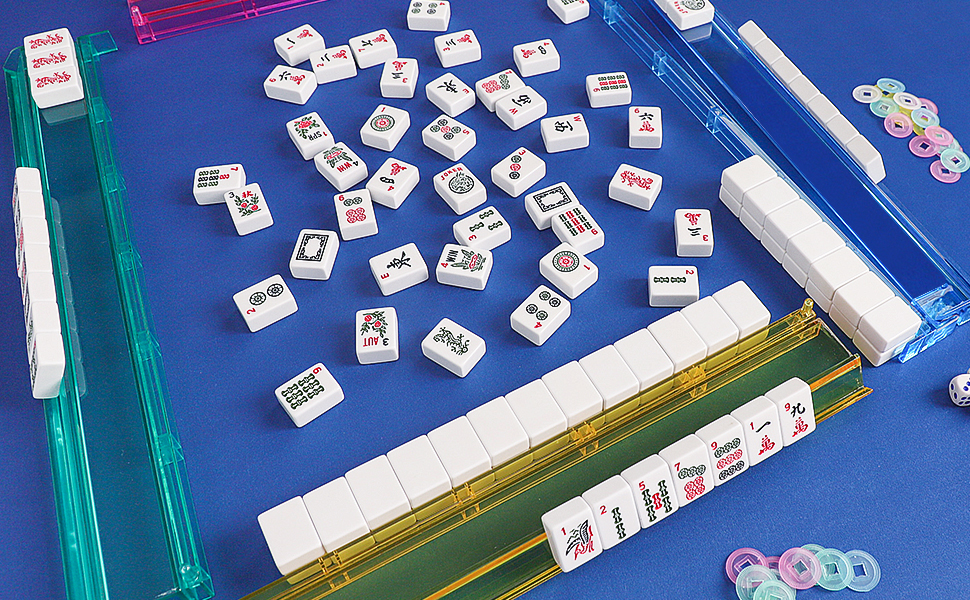Looking to join the ranks of chattering tables, clacking tiles, and friendly rivalries? You’ve come to the right place—because here at Stacyknows, I’m about to walk you through everything you need to hit the ground running in the wonderful world of Mah Jongg.
1. Meet the Tiles
A standard American Mah Jongg set has 152 tiles divided into:
- Suited tiles (Bams, Dots, Craks): numbered 1–9 in four copies each.
- Honors: Winds (East, South, West, North) + Dragons (Red, Green, White), four copies each.
- Jokers and Flowers/Seasons: jokers are wild cards; flowers/seasons are bonus tiles used for special scoring.
Pro tip: start by riffle-shuffling small stacks in your hands to mix the tiles; it’s way more satisfying than banging them on the table.
2. Learn the Lingo
- Pung: three identical tiles.
- Kong: four identical tiles (counts as one meld).
- Chow: three consecutive suited tiles (only on your left).
- Pair: two identical tiles (you need one pair to complete your hand).
- Joker: wild tile that substitutes for almost anything—use sparingly, though.
Memorize these five terms, and you’ll be halfway to speaking “Mah Jongg.”
3. The Goal: Build a Winning Hand
You need four melds (pungs/kongs/chows) plus one pair. Here’s a quick strategy framework:
- Watch your Jokers. They’re precious; don’t blow them on trivial melds.
- Aim for simpler patterns your first few games—pure pungs or mixed chows—before tackling complicated hands from the card.
- Discard wisely. Early on, ditch isolated honors (like lone winds) unless they’re your seat wind or prevailing wind.
4. Reading the Card
Every year, the National Mah Jongg League publishes a scoring card listing dozens of hands ranked by difficulty and point value. As a beginner:
- Stick to hands in the lower half of the card (Patterns 1–25).
- Circle your targets—it’s easier to focus on “Two Mixed Pungs” than bombarding yourself with 70+ options.
Keep a copy on the table or on your phone; it’s your roadmap to victory.
5. Table Etiquette & Pace
Mah Jongg is as much about camaraderie as it is about tiles:
- Don’t hog the wall—pull two or three tiles at a time, not ten.
- Call clearly—when you want to “Pung!” or “Chow!”, announce it so everyone hears.
- Be patient. Players of all levels will bend your deadlines for discards at first; just smile and wait.
6. Where to Play
- Community centers and senior centers: Often host free or low-cost beginner-friendly groups.
- Local mah jongg clubs: Google “[Your Town] mah jongg” or check Meetup.com.
- Online: Websites like Mahjong Time let you practice against global players on your own schedule.
7. My Favorite Finds
- The “Card Holder”—a simple plastic stand that keeps your 2025 card visible and tile-free.
- Foldable Mah Jongg Table—compact, lightweight, and perfect for small apartments.
- Color‑coded racks—so you can instantly spot left vs. right melds without squinting.
All under $25—proof that you don’t need to splurge to look like a pro.
Ready to Dab Your “Chow”?
Learning Mah Jongg is like building a friendship: give it time, show up consistently, and laugh when you mix up your Bams and Craks. Stamp your copy of the 2025 card, round up three friends, and let the tiles fly—Stacyknows will be right there cheering you on.
Have questions or want to share your first “Mah Jongg moment”? Drop a comment below, and let’s keep the conversation going—because here, every new player is a friend waiting to happen.

